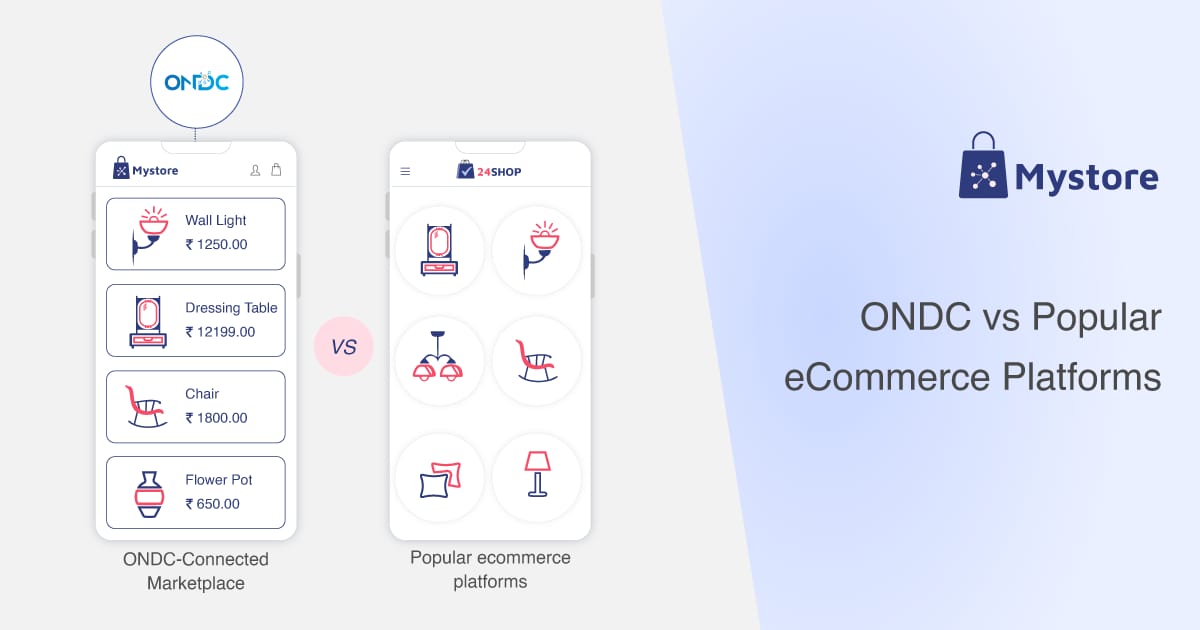India has always been an SME-oriented economy where millions of small, local sellers collectively contribute to the nation’s growth. However, over 90% of these sellers aren’t connected to any eCommerce platform and the ones who are, complain that they don’t get the same visibility and transparency as other prominent players.
Many small sellers venture into the world of eCommerce in India without fully understanding the perks and challenges that come with this modern approach. While adding a digital presence to your brick-and-mortar shop can certainly be rewarding, it’s the big players that tend to benefit the most from partnering with traditional eCommerce platforms.
Existing market leaders, for all their perks, do have some major flaws that negatively impact the small seller. Thankfully, Open Network for Digital Commerce Protocol (or ONDC Network) is a government-led initiative that aims to address the flaws in India’s leading eCommerce marketplaces.
What Differentiates ONDC Network From Traditional eCommerce?
Launched in September of 2022, the ONDC Network was tested in a few pilot cities with over 400 sellers and 17 apps made live on its first day. It is envisioned that once in full effect, the ONDC Network will expand its reach to cover everything from clothing, and food delivery to travelling and automotive.
To an untrained eye, the ONDC Network might seem similar to any other eCommerce platform with the exception of being an Indian entity. However, that couldn’t be further from the truth. Here’s how the platform is categorically different from a traditional eCommerce enterprise -
1. ONDC Network doesn’t adopt a platform-centric model
The ONDC Network plans to move India’s eCommerce ecosystem away from the existing platform-centric model (adopted by popular brands like Amazon & Flipkart) in favour of an open-network model. Here, merchants and customers can conduct transactions regardless of what apps or platforms they use. The ONDC Network doesn't require buyers and sellers to use the same platform to be able to connect and do business.
Everyday business tasks such as seller onboarding, setting prices, sales monitoring, and product cataloguing will become open source. Pan-India sellers will benefit from selling their goods to a wider online audience on the open network. The ONDC Network will put Indian SMEs on the map and help them compete with dominant eCommerce brands. The vision here is to gradually build a network that provides all kinds of sellers equal visibility and growth opportunities across multiple platforms.
2. ONDC Network provides more options
Today, there are over 500 logistics companies and 20,000+ active businesses offering hotels and travel services on eCommerce. However, a frequent online buyer would notice that only a handful of sellers repeatedly show up on their search results, thus greatly limiting their options. Through the ONDC Network India, the government wants to create a unified platform where all entities (sellers, logistics, delivery, tech partners, etc) along with their millions of customers have a more wide-spread interaction.
Vendors from Flipkart, Amazon, Myntra, etc can enlist products using the the ONDC Network seller app and buyers can then choose their preferred seller. Indian sellers who have little experience selling online can easily upload their catalogues, track orders & sales, and use marketing to enhance their digital presence using a prominent, feature-rich ONDC Network-compatible seller app (such as Mystore). The ONDC Network provides more options to sellers and buyers alike thus enhancing the experience on both fronts.
3. ONDC Network isn’t privately-owned
The entire world knows Jeff Bezos as the brains behind the biggest eCommerce juggernaut of them all, Amazon. Similarly, most popular online shopping platforms are privately-owned entities where one person calls the shots. Of course, business owners will dictate all terms of services and seller policies to maximize the company’s profitability. This often leads to less-than-favourable business terms for small sellers, most of whom are already operating on a razor-thin profit margin.
However, the ONDC Network is not owned or regulated by one major agency or business entity. That’s because the ONDC Network is not a service or an application. Rather, it’s a backend eCommerce network where buyers, suppliers, payment portals, and logistics connect through a set of open-source protocols. Therefore, ONDC Network-affiliated sellers don’t have to deal with many of the issues that privately-owned companies have; such as contractual lock-ins, preferential algorithms, and minimal transparency.
4. Seller Reviews are transferable throughout the network
From a seller’s perspective, migrating from one eCommerce behemoth to another can be massively counter-productive. All the positive reviews they’ve amassed over the years will all be lost if they wish to switch marketplaces. Hence, small sellers don’t consider the effort worthwhile and stick with the same platform with the same exploitative policies.
But with the ONDC Network, that is all about to change. Buyers from different platforms will be able to see a seller’s ratings and make a more informed decision. Similar to how UPI was implemented as a universal payment portal, the ONDC Network will serve as one unified network where seller and customer data is all accumulated in one place.
5. Becoming a seller on the ONDC Network is far more cost-friendly
Doing business with a popular marketplace is not a “free for all” privilege; far from it. In exchange for their widespread reach, technical support, and technologies, most giant corporations charge retailers a hefty commission fee (ranging from 18-40% of cart value). Indian SMBs and neighbourhood sellers don’t have the financial means to pay such a high fee and may struggle to keep their businesses afloat.
That’s why when the ONDC Network was first introduced, many small players rejoiced when they realized just how cost-friendly becoming a seller on the open network was. Compared to hefty commissions charged by popular eCommerce companies, shopkeepers can access the ONDC Network platform at a fraction of the cost (which can be 4 to 10 times less). Here, the commission fee would be dictated by the market and not the government or a committee of business personnel.
Conclusion
It should be noted that the ONDC Network initiative isn’t about eliminating the biggest players. The plan is to democratize the eCommerce industry that has traditionally been dominated by a handful of entities. Regardless of their technological and financial background, anyone can grow their seller journey through a robust and functional ONDC Network seller app, such as Mystore.
Mystore offers both the Mystore buyer app and Mystore seller app to bridge the gap between buyers and sellers for a seamless exchange of goods and services on an open digital network. If you’re excited by the prospect of selling to a much wider audience and using Mystore’s best-in-class features to scale your business, then feel free to register with us today.



